USS Shangri-La (CVA-38) Welcome Aboard - 1950s
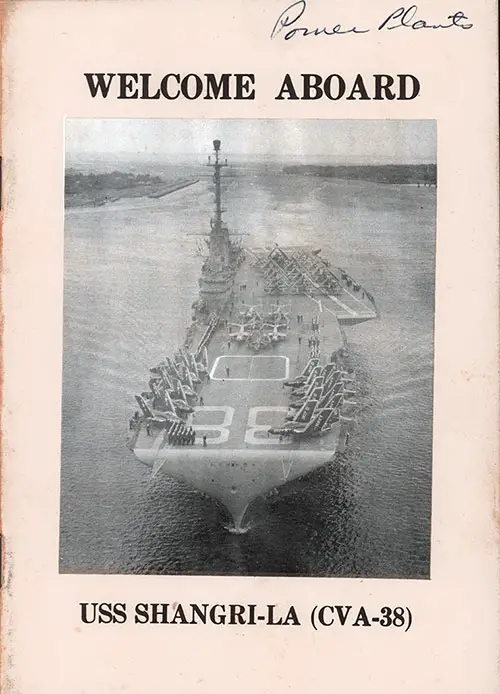
Front Cover, USN Brochure: Welcome Aboard, USS Shangri-La (CVA-38), nd circa late 1950s. GGA Image ID # 16dd5a1815
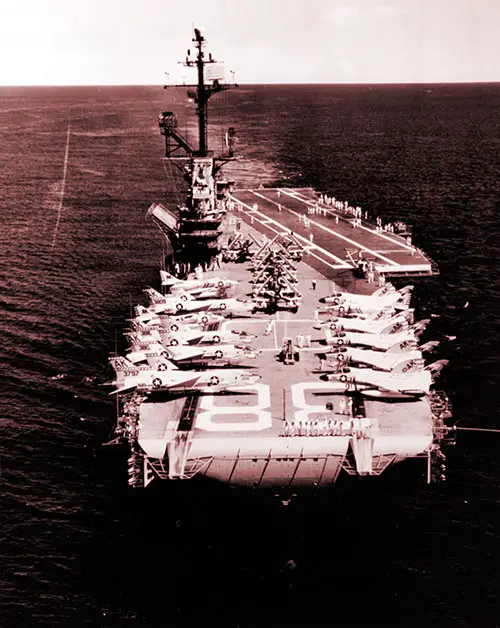
USS Shangri-la (CVA-38) Underway at Sea off Mayport, Florida, With Carrier Air Group Ten (CAG-10) Embarked, August 1960. Aircraft Parked on the Forward Flight Deck Include F8U and F4D Fighters, A4D and AD Attack Planes. Photographed by PH1 R. A. Moulder. Official U.S. Navy Photograph, From the Collections of the Naval History and Heritage Command. GGA Image ID # 16dda0c51b
TABLE OF CONTENTS
- Greetings Shipmate
- Shangri-La Pride of the Pacific
- Courtesy
- A Word to the Wise
- Leave and Liberty
- Damage Control
- What to Do and What not to Do
- Diagram of Ship
- The Air Group
- General Information
- Getting Around
- Locations Aboard Ship
- Post Office
- Personal Assignments
GREETINGS SHIPMATE
Welcome aboard the USS Shangri-La, first and foremost of the Navy’s modern attack carriers.
Your new ship is a mobile airbase that can move rapidly on offense and defense. Our air group gives us a tremendous striking power that can be projected great distances with conventional or special weapons. In a time of war, this striking power would present a devastating threat to any enemy. In a time of peace, it forms a powerful deterrent to any aggressor.
The Shangri-La and its air group help to make up the world’s third largest air force topped only by the U.S.S.R. and the United States Air Force.
During your tour aboard, you will be important to the ship. At times, the lives of as many as 3,000 men may depend on you and how you apply yourself to your duties and the manner in which you observe safety regulations.
In the relatively short life of the Shangri-La, she has earned a proud place in Naval history. Always strive to keep her just as proud of you as you are of her.
SHANGRI-LA - PRIDE OF THE PACIFIC
When the press asked President Roosevelt to identify the base, actually the USS HORNET, from which General Doolittle led the initial air attack against Japan, FDR whimsically answered, "Shangri-La," meaning the mythical utopia featured in James Hilton’s novel, Lost Horizon.
Later, the HORNET was sunk, and this ship became her replacement. In memory of the HORNET’s exploits, she was given the name USS SHANGRI-LA, the first ship to bear that name.
Launched in February 1944, she was commissioned in September of that year. She later became known as the "Tokyo Express" because of her repeated attacks on the Japanese capital during the latter stages of World War II. She finished the war roaming off the Japanese coast, fighting off suicide air attacks while her aircraft dealt merciless beatings to airfields and factories.
In June, 1947, she went into reserve, but was recommissioned in May 1951 for duty with the Atlantic Fleet. She steamed into Puget Sound Naval Shipyard in Bremerton, Washington, in September 1952 for a two year conversion that made her the most modern aircraft carrier afloat.
During the 26 months in the yard the PSNS workers gave her the Navy's first structurally angled flight deck to permit simultaneous launching and landings of aircraft and to reduce landing accidents to a minimum; new high capacity steam catapults to permit larger aircraft to be operated; heavier arresting gear for recovering modern aircraft; and an enclosed bow for improved seaworthiness.
Since the SHANGRI-LA's recommissioning, several other carriers have steamed from various shipyards with angled deck conversions. But CVA-38 has continued her tradition of "firsts" throughout the fleet.
In September 1955, she was the first Navy ship to conduct a "Wives Cruise," an operation that was adopted by the entire Navy.
She was the first angled deck carrier to make a Far East cruise when she operated in that area from January to June 1956.
Another important "first” was recorded by her when all the newest Navy planes were flown oil her decks to the National Air Show at Oklahoma City over the Labor Day weekend of 1956. The flights originated from spots off Mexico, California and Oregon to demonstrate the carrier's mobility and striking power. All the participating aircraft were competing in various trophy events and all were timed by the National Aeronautical Association, the first time the NAA had timed an event from a ship.
COURTESY
Living in close contact with nearly three thousand men can be made a lot more pleasant if you are pleasant. Your thoughtfulness and common courtesy breeds respect between all hands, from the lowest rate to the highest rank.
Saluting is a mark of respect. In the morning, a salute and a cheerful "Good morning, sir!" to your officers, is not only military but also marks a sailor that is proud and alive.
Stand or sit at attention when you should and use the proper reply to orders. "Aye Aye, sir!" is another mark of a good sailor.
Remember, when in doubt, salute!
Be helpful and courteous when visitors are aboard. You are responsible for their safety and behavior. Guests are restricted from all restricted spaces, mess decks and living compartments. Their visiting hours are from 1300 to 1600 on Saturday, Sunday, and during holiday routine, although exceptions may be made. Permission must be granted by the Officer of the Deck whenever visitors are brought aboard.
A WORD TO THE WISE
Those not properly instructed on aircraft fragility can cause great damage. So, unless you have business with the plane, "hands off!" is the word.
Stay clear of the Flight Deck, catwalks and the base of the island structure during flight operations.
The 07 level is a vantage point where you are allowed to witness flight operations. This is more popularly known as, "Vulture’s Row."
Fire hazards are greatest when refueling aircraft. The ward will be passed when aircraft are being fueled. DON’T SMOKE! Gasoline is highly vaporous and ignites easily.
LEAVE AND LIBERTY
Four section liberty is granted whenever the ship is in a Uni ted States port; three section liberty in foreign ports, hours are announced in the Plan of the Day and over the Public Address system.
Special liberty must be approved by your Department Head. It is granted in emergencies and to deserving personnel. Standbys, when needed, must be of equivalent rate and must not be restricted or standing by for another ran. Request chits are submitted through the chain of command prior to 1000 on the day liberty is desired.
All leave is granted by the Commanding Officer. The amount of leave and the number of personnel eligible varies according to the situation. Emergency leaves are expedited and verified by the Chaplain and the American Red Cross.
Make sure your uniform is regulation and that you are well groomed before you leave ship. Have your identification and liberty cards in your left hand and salute the OOD, saving, “I request your permission to leave the ship, sir!” After 0800 and before sunset, salute the national ensign when leaving the ship and coming aboard; Have a property pass for all gear you are taking ashore. Be prepared to have the OOD inspect your gear. Don't straggle or loiter about the quarterdeck or the accommodation ladder.
When you return aboard the ship, look alive! Salute the OOD saying, “I request permission to come aboard, sir!” Present your I.D. and liberty cards in your left hand. When you have received permission to return aboard, deposit your liberty card in the box provided for that purpose near the quarterdeck.
Missing the ship's movement is punishable by court-martial, so you will be wise to allow yourself plenty of time to make it back to the ship on time.
DAMAGE CONTROL
The USS Shangri-La is equipped with the finest, most modern system of compartmentation, i.e., watertight integrity, of any ship today. Because of this, the ship has a remarkable amount of reserve buoyancy and stability even if she is torpedoed.
But to be effective everyone must use the system properly. Undogged hatches, scuttles, or unsecured doors can be the Achille’s Heel of the ship. Therefore, when material conditions are set, adhere to them to the letter.
- X-Ray: Port condition
- Yoke: Cruising Condition
- Zebra: General Quarters
- W: Open at all times
- Circle W: Open at all times except when gas tight envelope is set.
- X: Closed at all times except when actually in use.
- Circle X: May be opened for access to battle stations only.
- Y: Closed during setting of Material Condition Yoke and Zebra.
- Circle Y: May be opened for access to battle stations only.
- Z: Closed when Material Condition Zebra is set, meaning General Quarters.
- Circle Z: Closed except when modified Material Condition Zebra is set.
- Z: Encircled by the letter "D." Closed during darken ship and Condition Zebra.
WHAT TO DO AND WHAT NOT TO DO
- Don't lean on lifelines. The water's wet and deep.
- Don't toss cigarettes, pipe ashes or matches overboard.
- Don't gamble. There are more sharks on ship than in the sea.
- Don't bring pets, liquor or radios aboard.
- Don't flush trash in the commodes.
- Don't throw trash on the deck. Keep the ship clean.
- Hands off all levers, buttons and gear that don't concern you.
- Turn in all gear adrift to the Master-at Arms shack.
- Keep your feet off paintwork.
- Conserve fresh water.
- Read the Plan of the Day. It's your responsibility.
- Heed all announcements on the public address system.
- Use no filthy or obscene language. It marks you as an ignorant person.
- Keep your locker locked at all times. Not everyone is as honest as you are.
- Leave no gear adrift.
- Relieve your watches on time. You expect the same.
- Walk fast, but do not run, to General Quarters and all emergency drills.
- Report immediately all ship’s gear you damage or lose.
- Lock up your wallet when you hit the rack.
- Don't stamp out cigarettes on the deck.
- Keep clear of Officer's Country unless on official business.
- Learn all your emergency drill stations.
- Become familiar with several routes to your emergency drill stations.
- Observe traffic patterns during emergency drills. Up and forward on the starboard side, down and aft on the port side.
- Wear a proper uniform at all times.
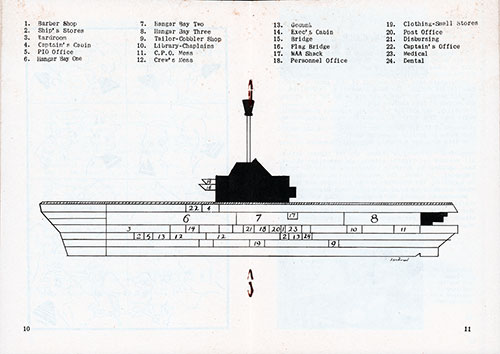
Cross-Section of the USS Shangri-La With Important Areas Identified to Help You Navigate the Ship. GGA Image ID #
- Barber Shop
- Ship’s Stores
- Wardroom
- Captain's Cabin
- PIO Office
- Hangar Bay One
- Hangar Bay Two
- Hangar Bay Three
- Tailor-Cobbler Shop
- Library-Chaplains
- C.P.O. Mess
- Crew’s Mess
- Gedunk
- Exec's Cabin
- Bridge
- Flag Bridge
- MAA Shack
- Personnel Office
- Clothing-anal1 Stores
- Post Office
- Disbursing
- Captain's Office
- Medical
- Dental
THE AIR GROUP
It takes no great amount of logic to state that without an Air Group there would be no justification for this ship or other carriers which are the floating airfields of the nation's defense forces.
Battleships have their mammoth 16 inch guns; a carrier has its Air Group. The main armament of SHANGRI-LA is the Air Group. The Navy's air arm is by far its strongest weapon in this nuclear age.
Mobility, the ability to deliver a potent punch continents away from anywhere, is not the sole reason for the existence of the Air Group, for the defense of the entire task force is greatly dependent on it.
On this ship, the Air Group is usually composed of four squadrons: interceptor planes; day jet fighter attack; all weather jet fighter attack; and propel lor attack. Each squadron is directly responsible to the Air Group Commander.
On shore, the squadron is a separate command.
On a carrier, the squadrons become divisions and the Air Group Commander is equal to a Department Head.
Detachments augment the squadrons. They are separate entities which are not part of the Air Group while stationed ashore. Photo, anti-submarine, night all-weather attack, airborne early warning, heavy attack and special weapons detachments are usually included on all carriers.
- McDonald F3H “Demon” - All weather interceptor equipped with afterburner.
- Douglas AD “Sky raider” - First plane to carry bomb load. greater than its own weight.
- Grumman F9F-8 “Cougar” - Interceptor, photo-plane, fighter, and bomber.
- N. American AJ “Savage” - Navy's first atom bomber.
- Chance Vought F7U “Cutlass” - Interceptor, and carries air to-air missiles.
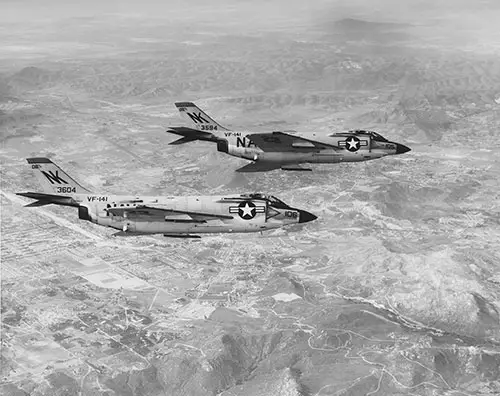
F3H-2 "demon" fighters Of VF-141, in flight, 13 February 1961. Photo by NAS Miramar. Naval History and Heritage Command. NH 71250. GGA Image ID # 16ddbf82e4
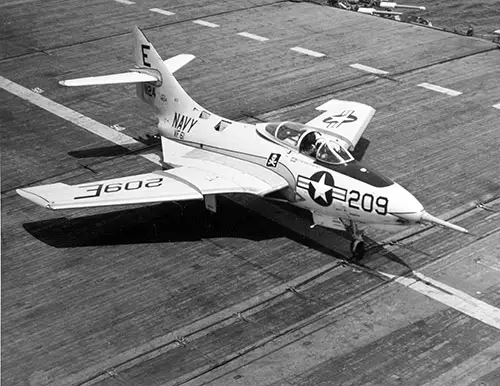
Grumman F9F-8 Cougar Fighter Plane. BUNO 141124 of Fighter Squadron 61 (VF-61) on the flight deck of USS INTREPID (CVA-11), 25 April 1956. Note the squadron insignia under the cockpit. Photographer, PM1 Wilcox. GGA Image ID # 16de542d25
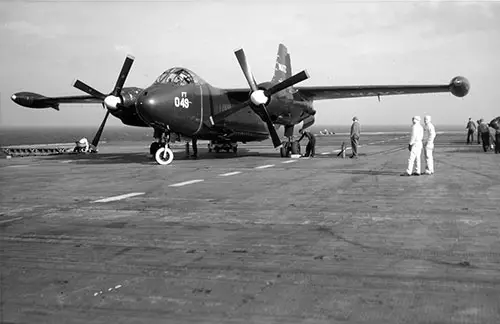
North American AJ-2 Savage Attack Plane On the flight deck of USS INTREPID (CVA-11), 19 November 1956. This plane is assigned to the Naval Air Test Center, Patuxent River, Maryland. Note the white sidewall nose tire. Photographer, S.E. Toy. GGA Image ID # 16dedf60a7
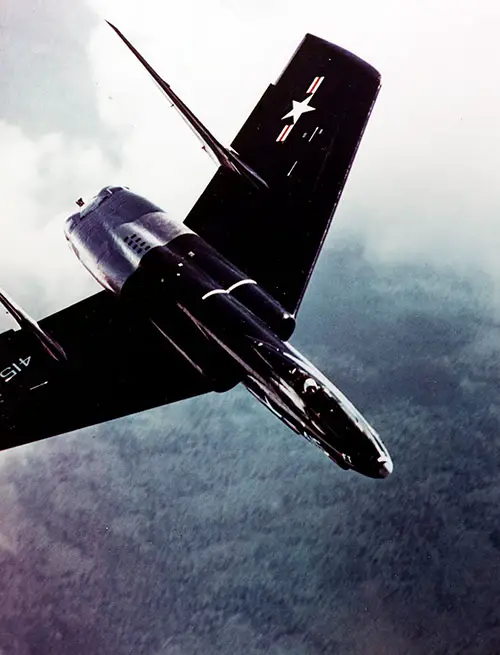
Vought F7U-1 Cutlass in flight, circa 1950s. Vought F7U-1 Cutlass in flight from Naval Air Test Center, Patuxent River, Maryland. Circa 1950s. Courtesy of the Photographer, Commander Richard Timm, USN Retired. GGA Image ID # 16defcd25d
GENERAL INFORMATION
SHANGRI-LA is a part of the Operating Forces of the U.S. Navy and is under Administrative control of Commander Air Force, U.S. Pacific Fleet.
Internally, SHANGRI-LA has nine departments, which are divided into 30 divisions. The departments are Administration, Operations, Air, Supply, Navigation, Gunnery, Engineering, Medical and Dental. When embarked, the Carrier Air Group assumes the status of a tenth department and the Carrier Air Group Commander functions similarly to a head of a department.
- Commissioned: 15 September 1944
- Decommissioned: 10 June 1947
- Recommissioned: 10 May 1951
- Shipyard Decommissioning: 14 November 1952
- Modernized, Recommissioned: 10 January 1955
- Displacement: 41,434 tons
- Beam (at waterline): 103 feet
- Width (maximum): 192 feet
- Draft: 30 ½ feet
- Speed: 30 knots plus
- Horsepower: 150,000
- Boilers: 8
- Screws: 4
- Complement: 3,000 (with air group)
- 3 inch gun mounts: 6
- 5 inch gun mounts: 8
- Length (overall): 889 feet
- Length (flight deck): 860 feet
- Number of aircraft (approx.) : 80
GETTING AROUND
You are no doubt a bit confused by the intricate maze of passageways, compartments, ladders, offices and other spaces about the ship. The following information is intended to help you become acquainted with your new ship.
The Shangri-La is divided into three sections. From the bow to Frame 80 is the “A” section; from Frame 80 to 150 the “B” section, and from Frame 150 to the stern is the “C” section.
The ship has 18 decks from the top of the island to the double bottom. Eleven decks are above the Main Deck (Hangar Deck) and seven are below. Decks above the Hangar Deck are numbered 01, 02, 03, etc. From the Hangar Deck down, they are 1, 2, 3, etc.
Compartments are numbered from forward to aft, with odd numbers on the starboard side and even numbers on the port side. Usually the section letter A, B, C, will precede the compartment number. The letter following the number indicates the use of the compartments.
A: Storeroom
C: Control
E: Machinery
F: Fuel
W: Water
L: Living
M: Ammo
T: Trunk and passage
V: Voids
NEWS ABOARD SHIP *38* is probably the best-informed capital ship afloat. Besides the Plan of the Day and the 1MC, there are three well established news sources on this ship.
The Daily News, published daily at sea, is a brief round-up of international news, local news and sport events.
The NEWS HORIZON, a weekly edition, deals with the ship's activities and information concerning all hands aboard.
In addition, the Chaplains have a daily 1800 newscast over the public address system while the ship is at sea.
ADMINISTRATIVE OFFICE (EXECUTIVE) - Frame 90 Comp. - B-201-4L Second Deck, Port.
You'll soon locate this office; for here the Ship's Notices and Instructions are distributed, and the Plan of the Day is published. The One (1) MC (Public Address System) and the Plan of the Day announce the liberty hours. All special request chits submitted to this office for approval by the Executive Officer or his representative must be sent through your division petty officer, division officer and department head. Telephone 646.
ATHLETIC GEAR LOCKER - Frame 165 - 01 Deck, Starboard
All sports equipment must be signed out on cards provided by locker attendant. Open from 0800-Movie Call.
AVIATION STORES A READY ISSUE ROOM - Frame 194 Comp. - C-0104-4A 01 Deck, Port
Aircraft parts for maintenance and upkeep of aircraft and pilot's equipment are issued in this compartment.
BARBER SHOP - Frame 121 Comp. - B-201-11L Second Deck Amidships.
Regulation haircuts are required, back and sides neatly trimmed, top cut to conform with shape of head. No full beards are allowed, although neat mustaches are permissible. Haircuts are free and no tipping.
OFFICER'S BARBER SHOP - Frame 8-12 Comp, A-130-1L Main Deck, Starboard
Haircuts are given by appointment only and may be made by phoning extension 283.
CHAPLAIN’ S OFFICE - Frame 169 Comp. - B-130-1L Second Deck, Starboard
Religious counsel, personal problems. Navy Relief and American Red Cross are attended by Roman Catholic and Protestant chaplains. Telephone 490 Protestant Chaplain only--Telephone 276
CLOTHING AND SMALL STORES - Frame HO Comp. - B-419-A Fourth Deck, Amidships
Regulation clothing items may be purchased for cash. Clothing allowances when substantiated by a letter from the Disbursing Officer may be used to buy items under credit. Resale of items is a violation of Navy regulations and is punishable by a court martial.
COBBLER SHOP - Frame 146 Comp. B-466-AL Fourth Deck, Amidships
All shoe repairs are made without cost. Telephone 570 Hours 0800-0900
CREW’S LOUNGE - Frame 166 Comp. - C-209-5L Second Deck, Starboard
This is to be used for various activities and as a meeting place for certain religious services. Open from liberty call to Taps in port; 1600-Taps at sea.
DISBURSING OFFICE - Frame 89 Comp.- B-201-1L Second Deck, Amidships
Pay accounts, records, travel claims and allotments, in fact, anything financial, is administered by this office. Telephone 456 Hours: 0800-1200
DENTAL OFFICE - Frame 133 Comp. - B-320-AL Third Deck, Port
Have your teeth checked twice a year? Appointments must be made in advance, except in case of emergency. Telephone 996 Dental Call: 0830
HOBBY SHOP - Frame 80 Comp. - B-401-L Fourth Deck, Starboard
Airplane, ship, train, boat and automobile models, leathercraft and other hobby materials are available at less than usual retail costs.
INFORMATION AND EDUCATION OFFICE - Frame 73 Comp. A-435-1L Fourth Deck, Starboard
Correspondence and training courses, USAFI tests, general educational information, training materials, applications for Navy schools and NAVCAD, NROTC, OCS, programs are available at this office. Telephone 627
LIBRARY - Frame 169 Comp. - C-2090-1L Second Deck, Starboard
The library contains approximately 3500 volumes of diverse type literature. Maps, magazines, reference and encyclopedia sets are also available. Books may be taken out for two weeks on signature. Telephone 490 Hours at sea: 1100-1245 1600-2130 Hours in port: 1100-1245 Liberty Call-1900
LUCKY BAG - Frame 114 Comp.- B-423-A Fourth Deck, Port
All gear found adrift, seabags, and deserter's clothing is stowed here in custody of the Master-at-Arms force.
MASTER-AT-ARMS OFFICE - Frame 125 Comp. B-0119-5L 01 Deck, Starboard
Under a Chief Master-at-Arms, the force is charged with maintaining order, discipline and cleanliness. MAA’s wear badges while on duty and are directly responsible to the Executive Officer. Telephone 647
PERSONNEL OFFICE - Frame 95 Comp. B-201-4L Second Deck, Port
This office handles all enlisted service records, orders for temporary additional duty, transfers, leave, schools and coordination of all enlisted activities. Telephone 095
PUBLIC INFORMATION OFFICE - Frame 72 Stateroom 317 Third Deck, Starboard
Acquainting the public with the Navy's part in the country's security is the job of PIO. A publicity questionnaire on every man aboard is kept in the office for preparation of news releases. Telephone 624
SHIP' S SERVICE FOUNTAIN - Frame 79 Comp. - A-321-1L Amidships
IN PORT HOURS
1300-1600
1800-2100
Open alternate days only.
'AT SEA HOURS
1300-1600
1800-2130
Open on working days only.
SHIP’S STORE
(FORWARD) Frame 71 Comp. - A-321-L Amidships
(APT) Frame 142 Comp. -B-318-L Amidships
AT SEA
No. 1
0900-1130
1300-1545
1800-2100 every other day
0815-1115 every other Sat.
No. 2
0900-1130
1300-1545
1800-2100 every other day
0815-1115 every other Sat.
SICKBAY - Frame 135 Comp. 3-215-1L Second Deck, Starboard
Regular sick calls are at 0800 and 1300. Emergencies will be treated anytime.
Telephone 999
TAILOR SHOP - Frame 145 Comp. 3-446-AL Fourth Deck, Starboard
Minor repairs and alterations and the sewing on of rates is done without charge. Restriping of jumpers is but another service.
POST OFFICE - Frame 117 Comp. 8-201-10L Second Deck, Port
Make sure your return addresses are complete. Your return address should read thusly:
JOHN A. DOB, Sn USN
"YOUR" DIVISION
USS SHANGRI-LA (CVA-38)
FLEET POST OFFICE
SAN FRANCISCO, CALIF.
Money orders, stamps, parcel pest, and registered mail services are provided. Your division Kill have a mail Petty Officer who will pick up your mail. Hours are:
AT SEA
- Money Orders: Mon-Fri - 0830-1130
- Paydays and two days after: 0830-1130 and 1300-1500
- Stamps-Registration and Parcel Post: Mon-Fri - 0830-1130 and 1300 to one half-hour before liberty call
IN PORT
- Money Orders: Mon-Fri - 0830-1130
- Paydays and two days after: 0830-1130 and 1300-1500 or one half-hour before liberty call
- Stamps-Registration and Parcel Post: Mon-Fri - 0830-1130 and 1300 to one half-hour before liberty call
